Introduction
Cows are members of the Bovidae family, which includes antelope, goats, sheep, bison and buffalo. Modern domestic cattle (Bos taurus) descend from the much larger, now extinct aurochs which once ranged throughout Africa, the Middle East, India, central Asia and Europe. Today, cows across the globe are farmed for beef, milk and leather.
Fascinating facts
Large and long-lived

Depending on the breed, cows can weigh between 80 and 280 stone (500 to 1,800 kg), with males (bulls) being bigger than females.1https://www.britannica.com/animal/cow When they’re allowed to live out their natural lifespan, cattle can live for 20 years and some, at sanctuaries, have lived into their 30s.
Cows don’t just eat grass
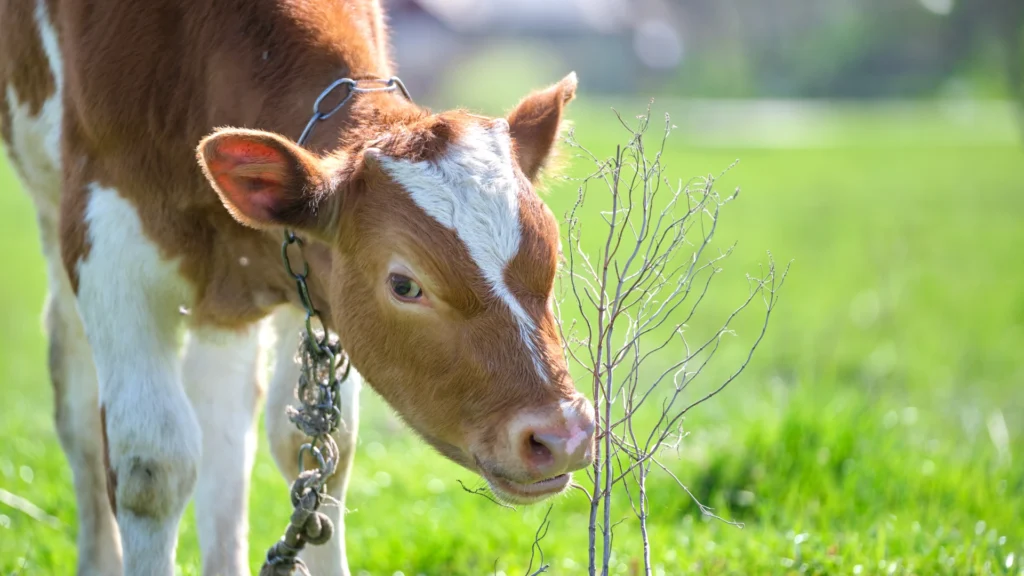
Contrary to the popular belief that cows just eat grass, they like a mixed diet. Just as people like different foods for breakfast and dinner, cattle prefer clover in the morning and grass in the evening. But if they could just choose one, they’d pick clover over grass.2https://www.sciencedirect.com/science/article/pii/S0022030204732816
Cows love games and puzzles
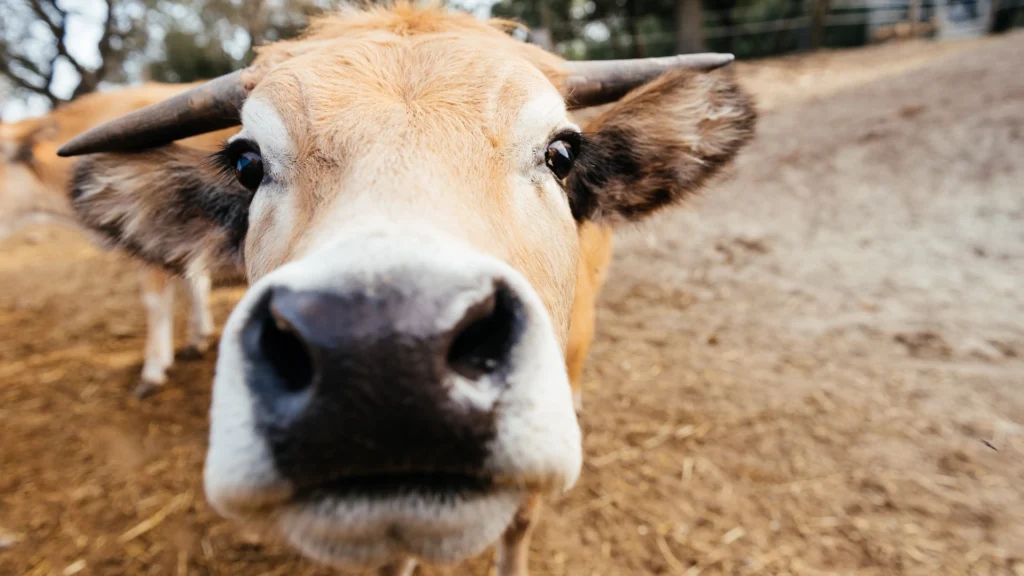
Cows have been known to play hide-and-seek, although they’re a bit too big to be very good at the game! Cows also like to problem-solve and can get excited when they find solutions.3https://www.theguardian.com/environment/2017/oct/30/secret-life-of-cows-loving-intelligent-kind-eat-them Cows are much cleverer than you think!
Cows have tight families and lifelong friendships
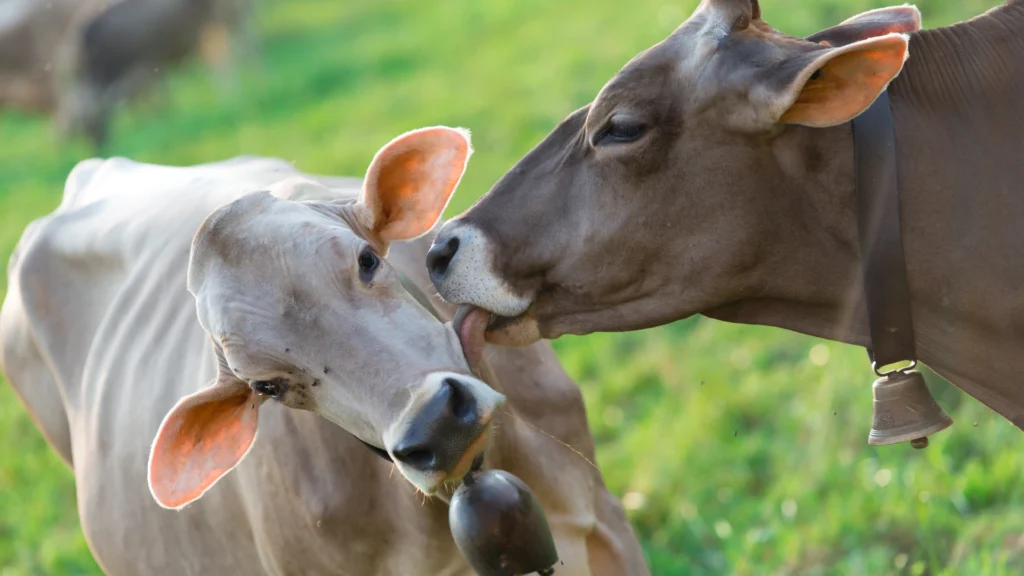
Within herds, the social structure is based on matriarchal families; mother cows and their daughters remain grooming and grazing partners for life and have very strong bonds with each other. Cows also form lifelong friendships with other cows to form a herd and calves befriend other calves for the rest of their lives.4Sowell BF, Mosley JC and Bowman JGP. 1991. Social behavior of grazing beef cattle: Implications for management. The American Society of Animal Science 77, 1-6.
Cows are extremely protective and caring of their offspring
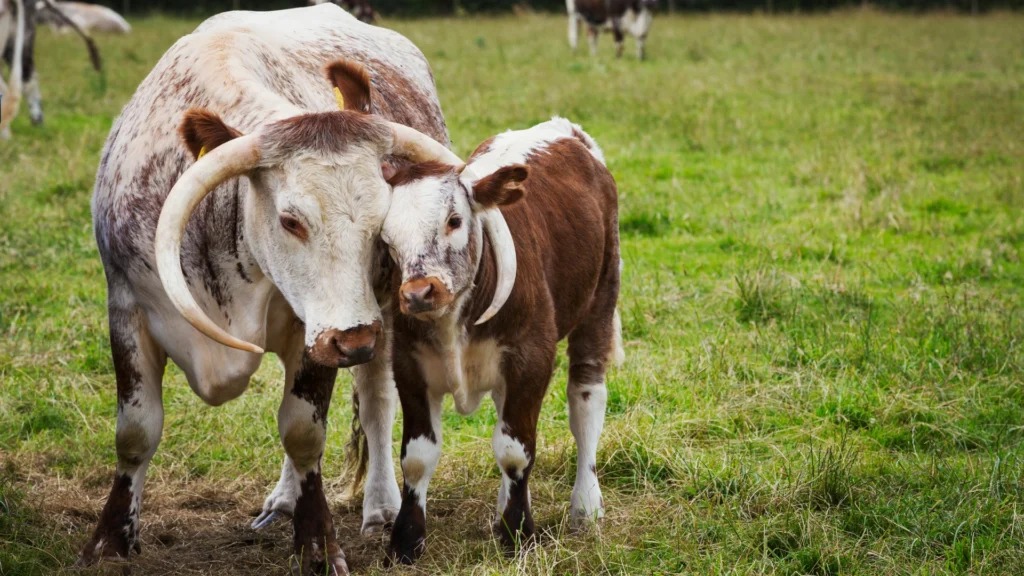
Mother cows give birth in private and hide the calf in long grass out of sight for about a week before introducing the newborn to the rest of the herd.4Sowell BF, Mosley JC and Bowman JGP. 1991. Social behavior of grazing beef cattle: Implications for management. The American Society of Animal Science 77, 1-6. The herd approves the new member who then joins them. Female calves suckle from their mother for nine months and then stay together for the rest of their lives. Male calves suckle for about a year and then leave to join a bachelor herd.
Cows are emotional animals
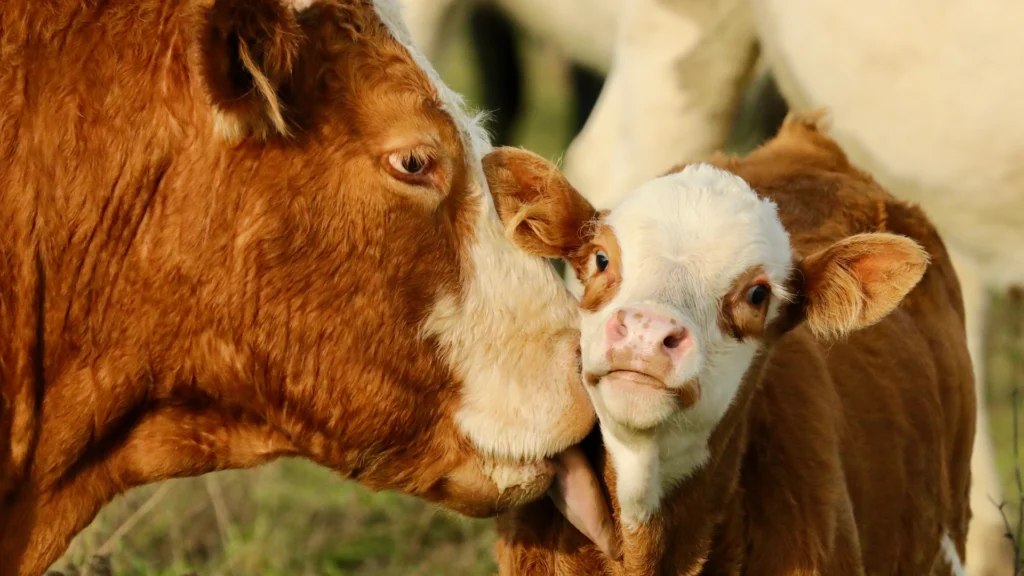
Herds like stability; any disruption to the group, such as the addition of a new member or the removal of another, can be very stressful.4Sowell BF, Mosley JC and Bowman JGP. 1991. Social behavior of grazing beef cattle: Implications for management. The American Society of Animal Science 77, 1-6. Cows grieve for calves they lose and can also feel depression and anxiety. For example, calves kept in isolation hutches – a standard practice in the dairy industry – show clear signs of depression, just like how solitary confinement affects humans negatively.5https://doi.org/10.1371/journal.pone.0090205
Cows are clever communicators
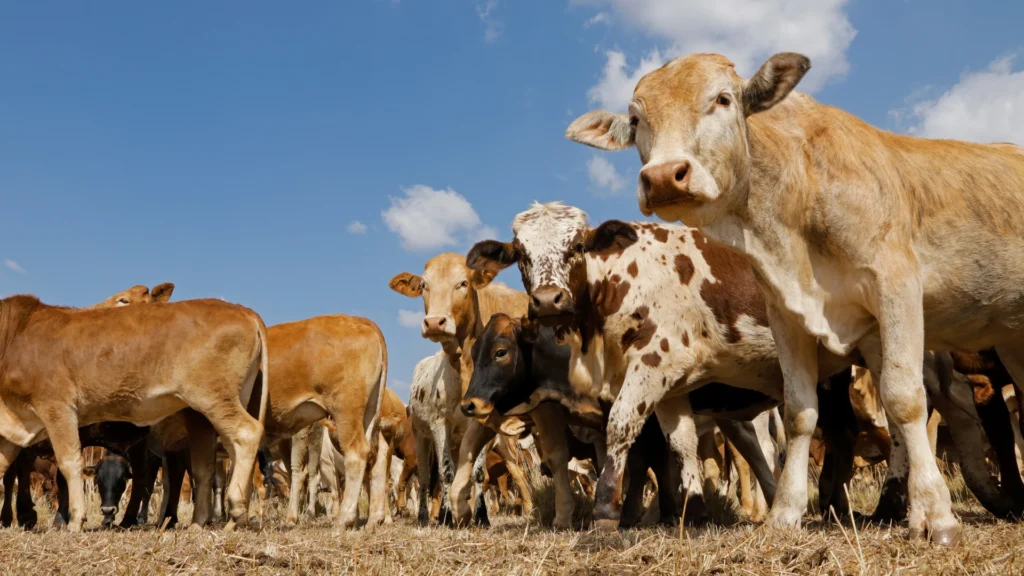
Cows make different noises to address different cows in the herd, just like people use different names for different individuals.6https://www.telegraph.co.uk/news/newstopics/howaboutthat/11297269/Cows-communicate-using-individual-sounds-like-human-names.html They recognise different people and will pretend that they haven’t been fed in order to get second helpings!3https://www.theguardian.com/environment/2017/oct/30/secret-life-of-cows-loving-intelligent-kind-eat-them
Cows can self-medicate
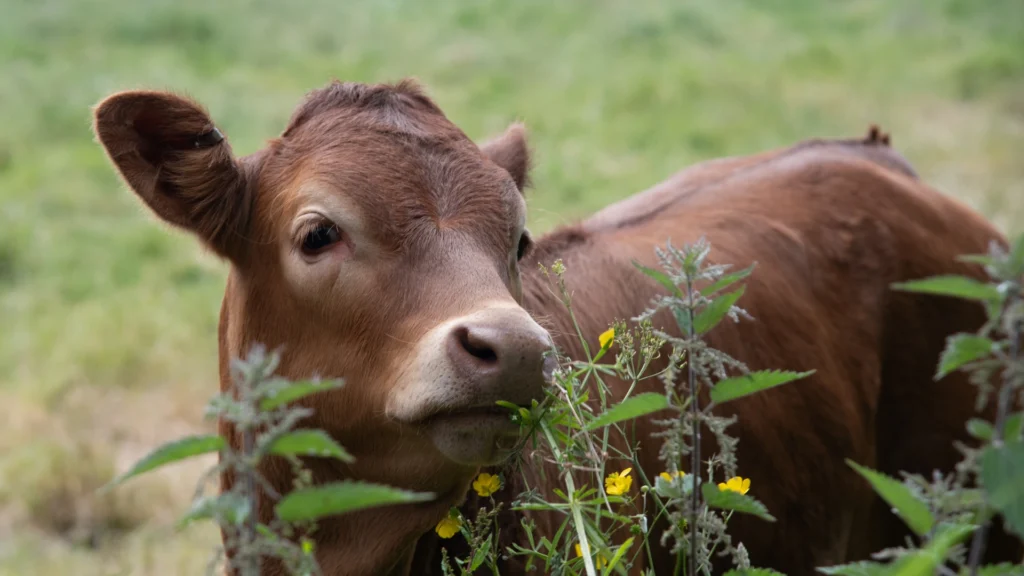
When they feel ill, cows choose to eat certain plants to help them feel better; similar to people eating more fruit or hot soup when feeling sick!3https://www.theguardian.com/environment/2017/oct/30/secret-life-of-cows-loving-intelligent-kind-eat-them The great apes, such as chimpanzees and gorillas do this too, so a cow’s understanding of the natural world is very sophisticated.
‘Beef’ cows in Uganda
According to the Food and Agriculture Organisation of the United Nations (FAO), Uganda had 6.2 million beef cattle in 20187https://www.fao.org/3/CA1904EN/ca1904en.pdf and by 2022, this number had almost doubled to 11.9 million.8https://www.fao.org/3/cc0930en/cc0930en.pdf In 2019, Uganda produced around 170,000 tonnes of beef9https://www.fao.org/fileadmin/user_upload/mafap/docs/MAFAP_Beef%20PI%20Uganda%20analysis_cc4776en.pdf, although some sources say this number is closer to 200,000.10https://www.indexbox.io/search/production-beef-uganda/ Either way, it’s safe to say Uganda’s beef industry is growing in terms of export and demand within the country.11https://www.statista.com/outlook/cmo/food/meat/uganda#revenue In 2022, 1,207,111 cows were killed in Uganda.12https://www.fao.org/faostat/en/#home
Around 25 per cent of Uganda’s population farms cows for beef on some scale7https://www.fao.org/3/CA1904EN/ca1904en.pdf, and beef farming occurs across the entire country, but especially in the “cattle corridors” of south western and north eastern Uganda.13https://naads.or.ug/download/beef-cattle/ Most of the country’s beef is exported to countries in the Middle East, such as Sudan, Egypt and Jordan.14https://thefarmersjournal.com/ugandas-meat-industry-takes-the-middle-east-by-storm-massive-monthly-beef-exports-to-egypt-unveiled/ The average Ugandan consumes about 9 kilograms of beef a year, compared to an average of 18 kilograms in the UK and 26 kilograms in the US.15https://ahdb.org.uk/beef-international-comparisons
How ‘beef’ cattle are farmed
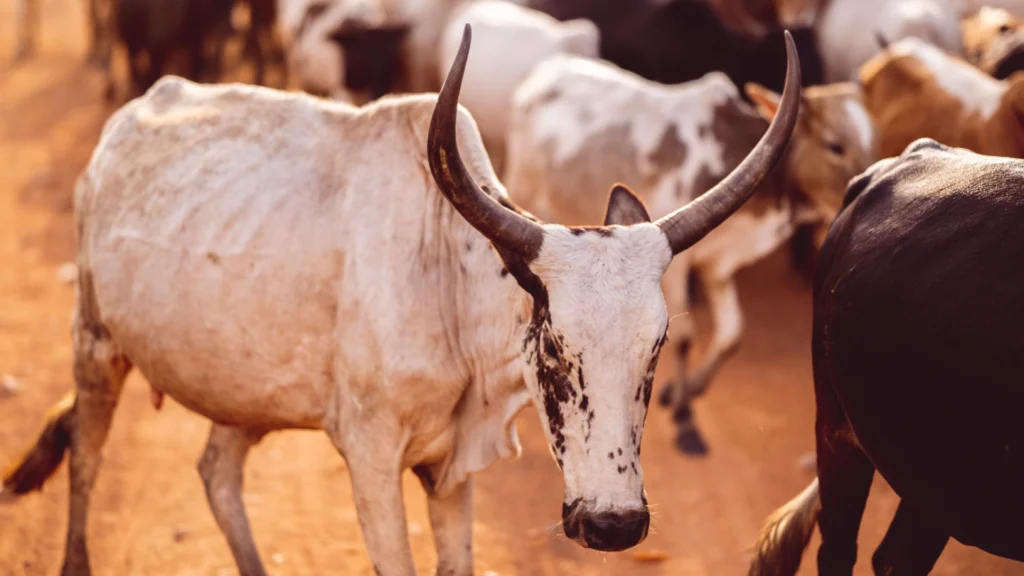
Farmers who exploit cows for beef, tend to focus on one of two aspects of beef farming: the raising of weaner calves for sale, and then the fattening of calves for eventual slaughter.16https://farmkioskafrica.com/farming-practices/details/beef-cattle-farming In Uganda, beef cattle are farmed in four different systems: ranching, pastoral, agro-pastoral, and semi-intensive.7https://www.fao.org/3/CA1904EN/ca1904en.pdf
Ranching
In this system, between 500 and 3,000 cows are kept within perimeter fencing, paddocked structures and grazing fields. The farms usually contain a mixture of indigenous and exotic breeds. According to the FAO, “the primary purpose of this system is production and marketing of beef cattle and a few breeding cattle with milk being a by-product.” Only eight per cent of Uganda’s beef cows are farmed this way.7https://www.fao.org/3/CA1904EN/ca1904en.pdf
Pastoral
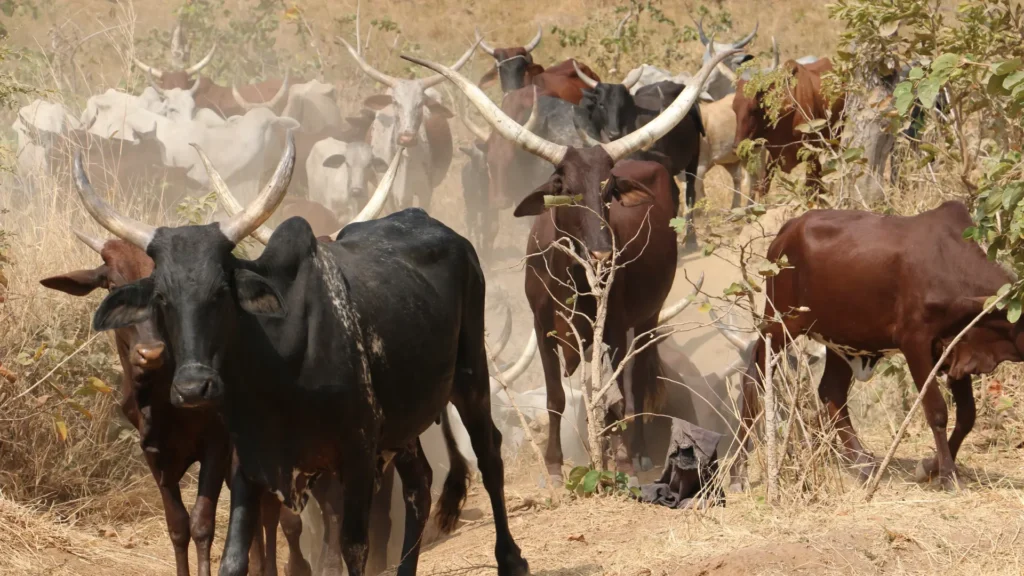
In the pastoral system, the farmers move the cows around, in search of the best pastures and water supplies. The herds of up to 100 cows are made up of indigenous breeds, usually Zebu. Their main product is beef but they also take the cows’ milk, blood, hides, manure and horns. Forty-one per cent of Uganda’s beef cows are farmed this way.7https://www.fao.org/3/CA1904EN/ca1904en.pdf
The cows in pastoral systems are susceptible to undernourishment and dehydration as they rely on what nature can provide.13https://naads.or.ug/download/beef-cattle/ Unfortunately, in the last 30 years, barren land has increased by 200 per cent7https://www.fao.org/3/CA1904EN/ca1904en.pdf, making it much harder for the cows to find good quality grass to graze on. The cows are also responsible for over-grazing therefore contributing to biodiversity loss and the degradation of habitats.
Furthermore, cows are also more susceptible to parasites, such as ticks, and contracting zoonotic diseases (diseases that jump from animals to people) as they come into contact with many parasites and pathogens, especially Brucellosis and Bovine tuberculosis7https://www.fao.org/3/CA1904EN/ca1904en.pdf and pastoralists have very limited access to animal health services.13https://naads.or.ug/download/beef-cattle/
Agro-pastoral
The agro-pastoral system is the most common system for beef farming in Uganda, with 49 per cent of Uganda’s ‘beef’ cows being farmed this way.7https://www.fao.org/3/CA1904EN/ca1904en.pdf In this system, farmers graze cattle on private and public pastures, and feed them crop by-products. Like the pastoral system, the main product is beef but they also take the cows’ milk, blood, hides, manure and horns. The agro-pastoral system accounts for 55 per cent of all carbon dioxide emissions from cattle in Uganda, and each cow produces 2.29 tonnes of CO2 per year.7https://www.fao.org/3/CA1904EN/ca1904en.pdf
Semi-intensive/intensive

In this system cows are farmed for beef and some milk, and two per cent of Uganda’s beef cows are farmed this way.7https://www.fao.org/3/CA1904EN/ca1904en.pdf This might seem like a small number but as we have seen with the expansion of factory farming in all other parts of the world, it is also increasing in Uganda.
The cows are kept confined in kraals, paddocks and cattle stalls and fed with compound feed, never allowed to graze. It is only called “semi-intensive” because the cows are usually cross-bred, but make no mistake, this is an intensive method of factory farming.7https://www.fao.org/3/CA1904EN/ca1904en.pdf
As with all factory farming, the impact on the animals and the environment is devastating. This method might be the most profitable but at what cost?
Firstly, this system has the highest carbon dioxide emissions, at 3.11 tonnes of CO2 per year per cow, and accounts for three per cent (and rising) of total cattle emissions in Uganda.7https://www.fao.org/3/CA1904EN/ca1904en.pdf Waste management will also become an issue and is bound to pollute the local environment and destroy natural habitats. The knock-on effects for Uganda’s incredible wildlife would be disastrous.
On top of that is the inappropriate use of antibiotics we so often see in factory farms around the world. The FAO warn us that some of the emerging zoonotic diseases found on Ugandan factory farms “may have pandemic potential”. Bacterial and viral diseases can spread easily in intensive and semi-intensive conditions because animals are crammed too closely, they frequently become ill and their immune systems become compromised so that disease takes hold more easily.7https://www.fao.org/3/CA1904EN/ca1904en.pdf
The FAO concluded that: “livestock production is increasingly affecting the environment in terms of biodiversity loss, loss of soil cover, through overgrazing and is directly and indirectly affecting the public health through the increasing cases of zoonotic diseases such as brucellosis, rift valley fever or tuberculosis among others.”7https://www.fao.org/3/CA1904EN/ca1904en.pdf
How beef cattle are killed
Journey to death
Before the cows even reach the horrors of the slaughterhouse, they have a brutal journey to make.17https://globalpressjournal.com/africa/uganda/brutal-journey-slaughterhouse-ignites-beef-animal-rights-activists/ Cows destined for slaughter at one of Uganda’s larger abattoirs, such as Kampala City Abattoir, are packed tightly into the back of a truck and have their horns and tails tied to the rails of the truck to hold them in place during the bumpy journey. The maximum number of cows allowed is always exceeded so that profits can be maximised as “following the regulations would not make economic sense” according to one farmer.17https://globalpressjournal.com/africa/uganda/brutal-journey-slaughterhouse-ignites-beef-animal-rights-activists/ City Abattoir receives around 30 trucks – or “torture chambers” – of terrified cattle every day.18https://www.newvision.co.ug/category/business/observe-animal-rights-before-slaughter-NV_88846
Cattle therefore have to endure cramped conditions in the blistering heat for hundreds of miles as they are transported from farm to slaughterhouse. Sometimes cows are mixed with much smaller goats, who are often trampled and killed during the journey.18https://www.newvision.co.ug/category/business/observe-animal-rights-before-slaughter-NV_88846 Even the farmers know it is a nightmarish experience for the cows, but they spare no pity. If a cow falls or won’t move, they’ll be violently kicked and struck with a cane until they find the strength to stand and stagger out of the truck.17https://globalpressjournal.com/africa/uganda/brutal-journey-slaughterhouse-ignites-beef-animal-rights-activists/
Even though the Animals (Prevention of Cruelty) Act, states that any person who “cruelly beats, kicks, ill-treats, overrides, overdrives, overloads, tortures or infuriates any animal” is guilty of the crime of cruelty, this is clearly not followed or enforced in the slightest.17https://globalpressjournal.com/africa/uganda/brutal-journey-slaughterhouse-ignites-beef-animal-rights-activists/
Slaughter
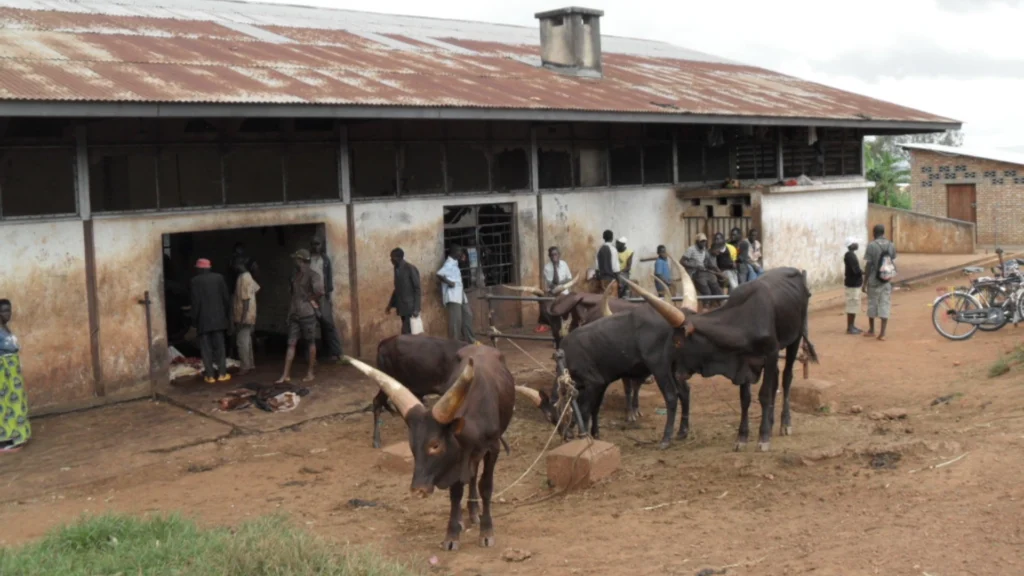
Cows are slaughtered in four different, but equally cruel, settings. First there is family slaughter, where a family kills a cow at home to feed the family. Secondly there is slaughter at a “slaughter slab”, either in a village or town. Then there are small slaughterhouses, and larger city abattoirs.19https://www.ugandainvest.go.ug/uia/images/Download_Center/SECTOR_PROFILE/meat_profile_sector.pdf
For beef sold at local markets, cows are killed in small slaughterhouses or at a slaughter slab.20https://www.slu.se/globalassets/ew/org/andra-enh/uadm/global/agrifose/phase-1/outputs/briefs/agrifose-brief-slaughter-hygiene.pdf The facilities at ‘official’ slaughterhouses are not much better and have been described as just “some upgraded slab”.21https://www.monitor.co.ug/uganda/business/prosper/uganda-s-meat-industry-promising-despite-the-filth-1485150 In fact, beef cannot be exported to European Union countries or the United States as Uganda’s slaughterhouses don’t comply with any meat quality standards.21https://www.monitor.co.ug/uganda/business/prosper/uganda-s-meat-industry-promising-despite-the-filth-1485150
All cattle killed in Uganda are “live slaughtered”, meaning they are not stunned before having their throats slit and being left to bleed to death in a pool of their own blood and faeces on a filthy concrete floor.18https://www.newvision.co.ug/category/business/observe-animal-rights-before-slaughter-NV_88846
One Ugandan journalist described the traumatising experience of visiting one of the main slaughterhouses in Uganda:
“Filth and absolute torture greeted us… The animals that were due for slaughter were being dragged on the floor and beaten with huge sticks. Some would be dragged around only to be heavily forced onto the ground, fracturing body parts in the process. Once at the abattoir the animals are not fed as they await their day of slaughter.”21https://www.monitor.co.ug/uganda/business/prosper/uganda-s-meat-industry-promising-despite-the-filth-1485150
The visit was so distressing that the journalist became a vegetarian on the spot.21https://www.monitor.co.ug/uganda/business/prosper/uganda-s-meat-industry-promising-despite-the-filth-1485150
On the infrastructure of the abattoir, “the drainage system is poor or non-existent and there are no essential facilities such as water supply, proper toilets, or professionally functioning office.” A report into the hygiene at several slaughter slabs in Uganda found that:
“There was also no sterilisation of cutting knives, no regular washing of hands or boots between activities and staff were not provided with cleanable plastic aprons. Two out of the three visited slaughter slabs were washed after slaughter using water only and one was not washed at all after slaughter. In the three slaughter slabs, the ruminant stomachs and intestines were opened and cleaned on the slab or in a separate area near the slab, but the contents were deposited close to the slab. The carcass inspection in two slaughter slabs was limited to the lymph nodes, the heart, lungs, and liver. No carcass inspection was observed in the third slaughter slab. In addition, the assistant inspectors were not aware of the code of meat inspection for Uganda in any of the slabs.”20https://www.slu.se/globalassets/ew/org/andra-enh/uadm/global/agrifose/phase-1/outputs/briefs/agrifose-brief-slaughter-hygiene.pdf
The investigators concluded that the conditions at both slaughter slabs and slaughterhouses pose significant health risks to Ugandans.
The only way to avoid animal cruelty and the health risks of eating meat is to stop eating meat. Beef is classified as a group 2 carcinogen by the World Health Organisation and processed meat (eg burgers, sausages) are classed as a group 1 carcinogen (they definitely can cause cancer).
References
References
- 1
- 2
- 3
- 4Sowell BF, Mosley JC and Bowman JGP. 1991. Social behavior of grazing beef cattle: Implications for management. The American Society of Animal Science 77, 1-6.
- 5
- 6
- 7
- 8
- 9
- 10
- 11
- 12
- 13
- 14
- 15
- 16
- 17
- 18
- 19
- 20
- 21

